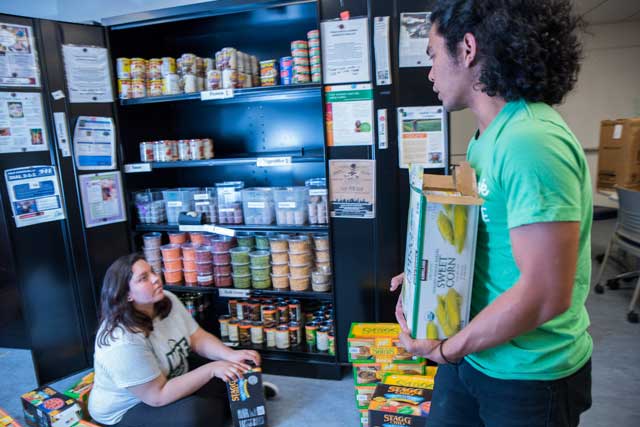
Housed in the Recreation & Wellness Center, the student-led organization has evolved into the hub of Humboldt State University’s effort to support food insecure students.
“We’ve become more visible and opened the conversation about hungry students at HSU,” says Health Educator Ravin Craig, who oversees the small group of student staffers, interns, and volunteers who run the program. “We also created a space that lacks shame and stigma that goes with food pantries and where people hang out, eat together, and talk about food in a communal environment.”
Oh SNAP! started in 2013 when students and Social Work Professor Jen Maguire began connecting students with state food assistance benefits known as CalFresh. With the help of Lead Health Education & Clinic Support Services Mira Friedman, Oh SNAP! opened the food pantry the following year and has served thousands of students while adding a slew of services along the way.
Early on, the program connected students with local community resources, held cooking demos, and provided recipes based on pantry ingredients. It now offers fresh produce each week during the fall. Oh SNAP! helped implement the University’s meal point donation program and just launched a pop-up thrift shop of donated items to help raise money for food and emergency housing needs as well as provide access to inexpensive housewares and clothing. In 2016, HSU became the second university in the nation to accept Electronic Benefit Transfer cards from the U.S. Dept. of Agriculture’s Supplemental Nutrition Assistance Program (“SNAP” lends the program its name). Students can also get help navigating the public health care system to sign up for insurance.
Logistics have been streamlined, too. In addition to helping students fill out CalFresh applications, an Oh SNAP! staffer works directly with the county to process applications. This saves students from the often confusing and frustrating process of contacting local agencies and getting papers signed by different campus entities.
“Before Oh SNAP! people on campus would give hungry students soup or granola they had stored in their office. Now we have a mechanism to feed people,” says Craig.
The food pantry and connection to services are part of HSU’s multi-pronged approach to tackling student hunger and housing insecurity on campus, while also pushing for changes throughout higher education.
On the research end are Maguire and her students, who have spent the last several years studying the issue. She teamed up with CSU Long Beach Professor Rashida Crutchfield to conduct the Basic Needs Initiative study. Commissioned by CSU Chancellor Timothy White, their research found that 42 percent of CSU students experienced low food security and 11 percent reported being homeless at some point during the previous year.
In March, Maguire, HSU President Lisa Rossbacher and others lobbied California legislators to advocate for more funding and policy changes to support food insecure students. Previously, in 2016, Maguire and Friedman testified before state lawmakers about HSU’s efforts to alleviate student hunger. Their testimony played a major role in the passage of a state law that makes CalFresh more accessible to state college students.
Craig emphasizes that the key to success has been and continues to be the students who run the pantry and choose which foods to purchase based on shifting tastes and needs.
“One of the things about pantry staffed by students who have their finger on the pulse of food trends is that they can bring information back to us,” says Craig.
They’re also behind the program’s shifting focus on sustainability. Oh SNAP! is now part of HSU’s extensive food recovery and redistribution system, which includes composting, changes in food purchasing, and education. For its role in the fight against food waste, Oh SNAP! built an app that notifies students if there are available leftovers from campus events. Dining services donates fresh produce left over at the end of the semester to Oh SNAP!, and students now have the option of donating their extra meal credits (J Points) to other students on an emergency basis.
These efforts have made a big difference: Oh SNAP! diverted about 1.62 tons of food from the landfill in 2017.
Oh SNAP! has also added sustainability education into its mix of workshops, providing classes on composting, recycling, and how to use CalFresh dollars to start gardens.
“We teach people about food systems and also how to produce food in a way that’s sustainable and good for their bodies,” says Craig.
As Oh SNAP! expanded, so too has its understanding of the students their services support. “We’ve learned we need to be ‘Humboldt-minded.’ That means integrating the sustainability aspect into our work and being more casual and accessible when doing outreach,” says Craig.
Craig’s ultimate dream is straightforward: to make basic needs a priority and help students meet those needs so they can be successful.
“We need to think about long-term solutions, such as increasing public transit access to healthy affordable food, and look at food systems in Humboldt County,” she says. “I agree with the idea that food is a basic human right—no one should have to think about where their next meal is coming from.”